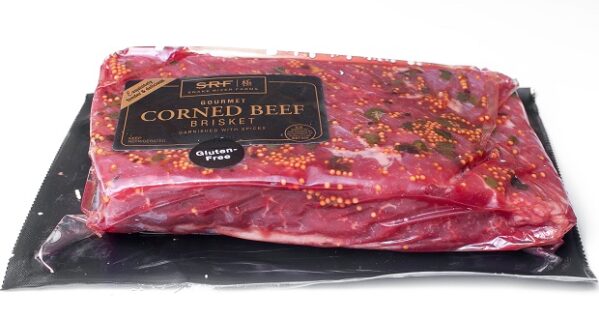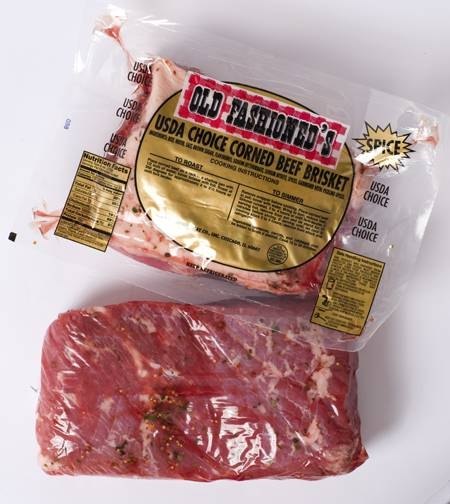I may be wrong but I thought salt beef was Jewish cuisine and meant to be really tender, My father used to play cards with Manny Cussins who was chairman of Leeds United at the time, it was my job to make him a bacon sandwich, always asking me, this is salt beef isn't it?
I have only had salt beef once at a Selfridges food counter and it took a helluva lot of chewing, put me off it for good.
Must admit I like a corned beef hash or a corned beef and pickled beetroot sandwich, maybe in a baguette.
These threads make me hungry!
From the web;
History[edit]
Although the exact origin of corned beef is unknown, it most likely came about when people began preserving meat through
salt-curing. Evidence of its legacy is apparent in numerous cultures, including ancient Europe and the Middle East.
[5] The word
corn derives from
Old English and is used to describe any small, hard particles or
grains.
[6] In the case of
corned beef, the word may refer to the coarse, granular salts used to
cure the beef.
[5] The word "corned" may also refer to the corns of
potassium nitrate, also known as saltpeter, which were formerly used to preserve the meat.
[7][8][9]
19th century Atlantic trade[edit]
Although the practice of curing beef was found locally in many cultures, the industrial production of corned beef started in the British
Industrial Revolution. Irish corned beef was used and traded extensively from the 17th century to the mid-19th century for British civilian consumption and as provisions for the British naval fleets and North American armies due to its nonperishable nature.
[10] The product was also traded to the French, who used it in
their colonies in the Caribbean as sustenance for both the colonists and
enslaved labourers.
[11] The 17th century British industrial processes for corned beef did not distinguish between different cuts of beef beyond the tough and undesirable parts such as the beef necks and shanks.
[11][12] Rather, the grading was done by the weight of the cattle into "small beef", "cargo beef" and "best mess beef", the former being the worst and the latter the best.
[11] Much of the undesirable portions and lower grades were traded to the French, while better parts were saved for consumption in Britain or
her colonies.
[11]
Ireland produced a significant amount of the corned beef in the Atlantic trade from local cattle and salt imported from the
Iberian Peninsula and southwestern France.
[11] Coastal cities, such as
Dublin,
Belfast and
Cork, created vast beef curing and packing industries, with Cork producing half of Ireland's annual beef exports in 1668.
[12] Although the production and trade of corned beef as a commodity was a source of great wealth for the nations of Europe, in the colonies the product was looked upon with disdain due to its consumption by the poor and slaves.
[11]
Increasing corned beef production to satisfy the rising number of people moving to the cities from the countryside during the
Industrial Revolution worsened the effects of the
Irish Famine of 1740-41 and the
Great Irish Famine:
The Celtic grazing lands of ... Ireland had been used to pasture cows for centuries. The British colonized ... the Irish, transforming much of their countryside into an extended grazing land to raise cattle for a hungry consumer market at home ... The British taste for beef had a devastating impact on the impoverished and disenfranchised [the] people of ... Ireland. Pushed off the best pasture land and forced to farm smaller plots of marginal land, the Irish turned to the potato, a crop that could be grown abundantly in less favourable soil. Eventually, cows took over much of Ireland, leaving the native population virtually dependent on the potato for survival.
—
Jeremy Rifkin, Beyond Beef
[13]
Despite being a major producer of beef, most of the people of Ireland during this period consumed little of the meat produced, in either fresh or salted form, due to its prohibitive cost. This was because most of the farms and their produce were owned by wealthy
Anglo-Irish landlords (many of whom were
often absent) and most of the population were from families of poor
tenant farmers, with most of the corned beef being marked for export.[
citation needed]
The lack of beef or corned beef in the Irish diet was especially true in the north of Ireland and areas away from the major centres for corned beef production. However, individuals living in these production centres such as
Cork did consume the product to a certain extent. The majority of Irish who resided in Ireland at the time mainly consumed dairy products and meats such as pork or
salt pork,
[12] bacon and cabbage being a notable example of a traditional
Irish meal.
Cultural associations[edit]
In North America, corned beef dishes are associated with traditional British, Irish, and Jewish cuisines.
[15]
Mark Kurlansky, in his book
Salt, states that the Irish produced a salted beef around the
Middle Ages that was the "forerunner of what today is known as Irish corned beef" and in the 17th century, the English named the Irish salted beef "corned beef".
[16]
Before the wave of 19th century
Irish immigration to the United States, many of the ethnic Irish did not consume corned beef dishes. The popularity of corned beef compared to
back bacon among the immigrant Irish may have been due to corned beef being considered a luxury product in their native land, while it was cheap and readily available in the United States.
[12]
The Jewish population produced similar corned beef
brisket, also smoking it into
pastrami. Irish immigrants often purchased corned beef from Jewish butchers. This exchange was an example of the close interactions in everyday life of people from these two cultures in the United States' main 19th and 20th century immigrant port of entry, New York City.
[12][17]
Canned corned beef has long been one of the standard meals included in
military field ration packs globally, due to its simplicity and instant preparation. One example is the American
Meal, Ready-to-Eat (MRE) pack. Astronaut
John Young sneaked a contraband corned beef sandwich on board
Gemini 3, hiding it in a pocket of his spacesuit.
[18]
Regions[edit]
North America[edit]
In the United States and Canada, corned beef is typically available in two forms: a cut of beef (usually brisket, but sometimes round or
silverside) cured or pickled in a seasoned brine, or cooked and canned.
Corned beef is often purchased ready to eat in
Jewish delicatessens. It is the key ingredient in the grilled
Reuben sandwich, consisting of corned beef,
Swiss cheese,
sauerkraut, and
Thousand Island or
Russian dressing on
rye bread.
Smoking corned beef, typically with a generally similar spice mix, produces
smoked meat (or "
smoked beef") such as
pastrami or
Montreal-style smoked meat.
Corned beef
hashed with potatoes served with eggs is a common breakfast dish in the
United States of America.
In both the United States and Canada, corned beef is sold in cans in
minced form. It is also sold this way in
Puerto Rico and
Uruguay.


